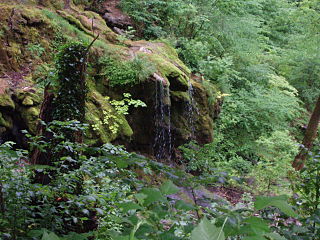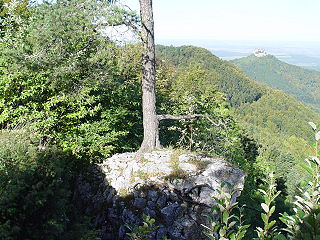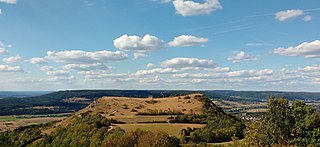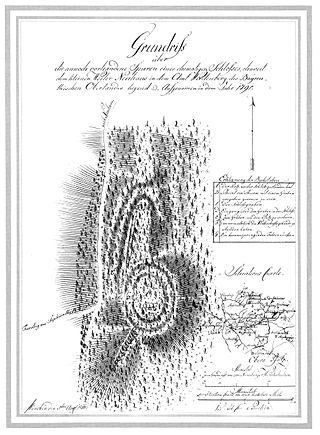
Franconia is a region of Germany, characterised by its culture and East Franconian dialect. Franconia is made up of the three Regierungsbezirke of Lower, Middle and Upper Franconia in Bavaria, the adjacent, Franconian-speaking South Thuringia, south of the Thuringian Forest—which constitutes the language boundary between Franconian and Thuringian—and the eastern parts of Heilbronn-Franconia in Baden-Württemberg.

The Main is the longest tributary of the Rhine. It rises as the White Main in the Fichtel Mountains of northeastern Bavaria and flows west through central Germany for 525 kilometres (326 mi) to meet the Rhine below Rüsselsheim, Hesse. The cities of Mainz and Wiesbaden are close to the confluence.

The Rhön Mountains are a group of low mountains in central Germany, located around the border area where the states of Hesse, Bavaria and Thuringia come together. These mountains, which are at the extreme southeast end of the East Hesse Highlands, are partly a result of ancient volcanic activity. They are separated from the Vogelsberg Mountains by the river Fulda and its valley. The highest mountain in the Rhön is the Wasserkuppe, which is in Hesse. The Rhön Mountains are a popular tourist destination and walking area.

The Murg is an 80.2-kilometre-long river and tributary of the Rhine in Baden-Württemberg, Germany. It flows through the Northern Black Forest into the Upper Rhine Plain, crossing the counties of Freudenstadt and Rastatt.

Franconian Switzerland is an upland in Upper Franconia, Bavaria, Germany and a popular tourist retreat. Located between the River Pegnitz in the east and the south, the River Regnitz in the west and the River Main in the north, its relief, which reaches 600 metres in height, forms the northern part of the Franconian Jura (Frankenjura). Like several other mountainous landscapes in the German-speaking lands, e.g. Holstein Switzerland, Märkische Schweiz, or Pommersche Schweiz, Franconian Switzerland was given its name by Romantic artists and poets in the 19th century who compared the landscape to Switzerland. Franconian Switzerland is famous for its high density of traditional breweries.

Neidlingen is a municipality in the district of Esslingen, in Baden-Württemberg, Germany.

Hesselberg is the highest point in Middle Franconia and the Franconian Jura and is situated 60 km south west of Nuremberg, Germany. The mountain stands isolated and far from the center of the Franconian Jura, in its southwestern border region, 4 km to the north west of Wassertrüdingen. The mountain's first recorded name was Öselberg, which probably derived from öder Berg. This name later changed to Eselsberg and finally to the current name Hesselberg. As a butte the mountain provides an insight into Jurassic geology. It has also witnessed an eventful history, many incidents were handed down from generation to generation and these mixed with facts have become legends. Nowadays many people visit Hesselberg in order to enjoy nature and the wonderful vista. When the weather is clear the Alps 150 km away can be seen.

The term Albtrauf refers to the northwest facing escarpment of the Swabian Alps, situated in Baden-Württemberg and Bavaria. It is the most distinctive stepped slope within the alpine region of the South German Scarplands, leading roughly from the southwest to the northeast.

The South German Scarplands is a geological and geomorphological natural region or landscape in Switzerland and the south German states of Bavaria and Baden-Württemberg. The landscape is characterised by escarpments.

The Rennsteig is a ridge walk as well as a historical boundary path in the Thuringian Forest, Thuringian Highland and Franconian Forest in Central Germany. The long-distance trail runs for about 170 km from Eisenach and the Werra valley in the northwest to Blankenstein and the Selbitz river in the southeast.

The Kanisfluh is a mostly isolated massif in the central Bregenz Forest Mountains between the municipalities Mellau and Au.The Kanisfluh is considered the most famous mountain and landmark of the Bregenz Forest, Vorarlberg, Austria.

The Ehrenbürg is a double-peaked butte on the edge of the Franconian Jura in Bavaria, Germany. It is in the district of Forchheim in Upper Franconia, in the municipalities of Kirchehrenbach, Leutenbach and Wiesenthau. The north peak is the 513.9 m Walberla, the south peak the 531.7 m Rodenstein. The hill is popularly known as the Walberla.

Itzgründisch is an East Franconian dialect, which is spoken in the eponymous Itz Valley and its tributaries of Grümpen, Effelder, Röthen/Röden, Lauter, Füllbach and Rodach, the valleys of the Neubrunn, Biber and the upper Werra and in the valley of Steinach. In the small language area, which extends from the Itzgrund in Upper Franconia to the southern side of the Thuringian Highlands, East Franconian still exists in the original form. Because of the remoteness of the area, this isolated by the end of the 19th century and later during the division of Germany, this language has kept many linguistic features to this day. Scientific study of the Itzgründisch dialect was made for the first time, in the middle of the 19th century, by the linguist August Schleicher.
The Upper Palatine-Upper Main Hills, also called the Upper Palatine-Upper Main Hills and Uplands form a landscape of low, rolling hills between the Franconian Jura in the southwest and the Franconian Forest, Fichtel Mountains and Upper Palatine Forest in the northeast.

Wellheim Castle is a former fortification in Upper Bavaria. The ruins of the old rock castle stand dominantly on Jurassic rocks above the market town of Wellheim in the ancient Danube valley. It was abandoned in the 18th century and partially demolished.

The Burgstall of Schlosshügel near Weidenberg is a lost hill castle or circular rampart site of the type known as a motte from the Early Middle Ages. It lies on the southern perimeter of the Fichtel Mountains at a height of 699 metres above sea level (NN) above the village of Sophienthal, which is part of the market borough of Weidenberg in the Upper Franconia county of Bayreuth in Bavaria. The burgstall or lost castle site was partly investigated by means of an archaeological test excavation and was also mapped several times in the past.
The Kalkberg is a high mountain located in the Franconian Alb near Weismain in the Upper Franconian district of Lichtenfels (Bavaria), Germany. It stands at an elevation of 454 metres (1,490 ft) above sea level.

The Krassach is a left tributary of the Weismain about 7 kilometers long, which flows into the Main near Altenkunstadt in Upper Franconia.
The Bärental is a small, 3.7 km long left-side valley of the Weismain Valley funnel within the Weismain-Alb region. It is situated entirely within the town of Weismain in the Lichtenfels district of Bavaria. This valley is located in the northernmost region of the Franconian Alb and is traversed by the Krassach River. Within the valley, there are 16 inhabitants, including the village of Krassach, 66 people. The three inhabited settlements are Herbstmühle, Krassacher Mühle, and Krassach. The valley holds appeal for hikers and is situated entirely within the nature park of Franconian Switzerland Veldensteiner Forest.

The Linnerberg, formerly also known as Linnberg, is a mountain located 757 meters above sea level in the Aargau Jura. It lies within the boundaries of the regional nature park Jurapark Aargau and stands as one of the highest peaks in the Brugg district. Together with the Gisliflue, which is located four kilometers further south, it constitutes the eastern terminus of the Faltenjura mountain range.





















